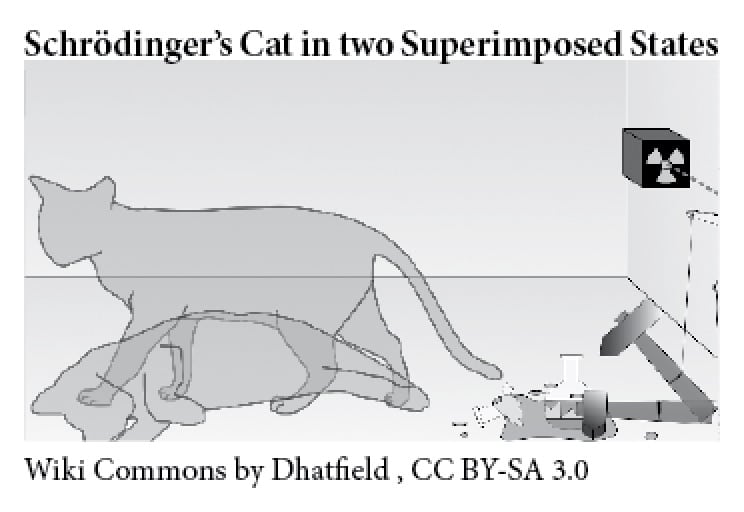
This post is a response to a question asked on my Quora site: Intelligence & IQ. The following explanation of Schrödinger’s cat is taken from my recent book, Intelligence: Where we Were, Where we Are and Where we’re Going.
In the famous double-slit experiment, an elementary particle like an electron or photon is sent through a barrier with 2 slits onto a fluorescent screen where it is detected. When both slits are open, the screen shows that the single particle creates a wave pattern, but when only one slit is open, it makes a single mark, at though it were a particle. Why does the photon behave differently depending on whether one slit or two slits are open?
In their interpretation of the double-slit experiment, Danish physicist Niels Bohr and a growing number of physicists suggested that before measurement, the photon exists simultaneously in two superimposed states: in one state the photon is passing through slit A and in the other state, passing through slit B. However, when an observer or a detector attempts to determine the slit through which the photon is passing, the two superimposed states collapse into one state and it is observed to be passing through a particular slit. This interpretation, held by Bohr and others, was called the Copenhagen interpretation. Meanwhile, Einstein continued to attempt (unsuccessfully) to create gedanken (thought) experiments that would refute the indeterminacy of quantum physics.
Erwin Schrödinger, the Austrian physicist who developed the wave function approach to quantum mechanics, believed in the indeterminacy of the quantum world, but disagreed with the Copenhagen interpretation of the two-slit experiment that invoked “ghost” particles and superimposed states of existence. Schrödinger proposed a gedanken experiment designed to show how the indeterminacy of the microcosm, would imply an implausible indeterminacy at the macrocosmic level. He imagined a cat placed in a sealed box with a radioactive source, a Geiger counter, and a glass flask containing cyanide. If the radioactive source emits an alpha particle–an indeterminate event– the Geiger counter detects it and emits a signal that activates a hammer that smashes the flask, releasing the poison gas and killing the cat. The Copenhagen interpretation would assert that since it is not known (by those outside the box) whether the radioactive source has emitted a particle, the alpha particle exists in the two superimposed states of emission and non-emission. Hence the cat must be simultaneously alive and dead, i.e., in two superimposed states of life and death, until the box is unsealed. Once the box is unsealed, the superimposed states would collapse into one state and the cat would be perceived as either alive or dead. Thus, an indeterminate or random event at the microcosmic level (the arbitrary emission of an alpha particle) would cause something at the macroscopic level (a cat) to exist in two superimposed states simultaneously.
Einstein responded to this gedanken experiment, by saying, “I cannot believe that the moon exists only when I look at it.” Others argued that the existence of the Geiger counter as a detector is an observer and should cause the collapse of the superimposed states into a single outcome. Still others muse (mews?) about the possibility that the cat, as a conscious observer, is enough to cause a collapse of the superimposed states of its existence. Though many physicists argue that superimposed states can occur only at a quantum level and not at the macrocosmic level of a cat, the Schrödinger Cat gedanken experiment has continued to generate debate among physicists and philosophers since its publication in 1935.
In essence, the Schrödinger cat thought experiment is an attempt to show that indeterminacy in the quantum world would imply indeterminacy in the macrocosmic world, which seems to run counter to our experiences. Einstein could not accept that the rejection of the idea that every observable event in our world is a unique result of prior causes. Yet, all his attempts to provide alternative explanations of the Copenhagen interpretation failed. Of course, this does not prove that the Copenhagen interpretation is correct; it just means that we have to continue our study of what Feynman called “quantum weirdness.”
